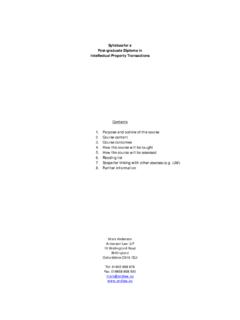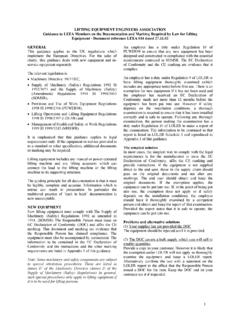Transcription of EU Block Exemption Regulation 2010 - Anderson Law
1 Copyright 2011 Anderson & Company 1 EU Block Exemption Regulation 2010 Checklist of requirements for an agreement to fit within the EU R&D Block Exemption Regulation 2010 By Mark Anderson , Solicitor Anderson & Company This note summarises the main requirements of the EU Block Exemption Regulation on Research and Development Agreements (Commission Regulation (EU) No 1217/ 2010 , OJ L 335/36). This Regulation provides Block Exemption from Article 101 of the Treaty on the Functioning of the European Union for certain types of research and development agreement. The purpose of this note is to provide a quick checklist for contract drafters who are familiar with the detailed terms of the Regulation .
2 The note should therefore be read in conjunction with the Regulation . Readers may also wish to consider our separate note on the main changes introduced by the Regulation over an earlier R&D Regulation , which appears on this website. REQUIREMENT/CONDITION DETAILS What type of agreement is it? It must be an R&D agreement (Article exempts) It cannot be primarily an assignment or licence of IP (Article ) although it can include IP terms Article : R&D agreement includes: Joint r&d + joint exploitation Joint exploitation of r&d after earlier agreement Joint r&d alone Paid-for r&d + joint exploitation Joint exploitation after paid-for r&d Paid-for r&d alone Joint exploitation includes exclusive licensing to one of the parties ( (m)(iii) and (o)) All parties must have access to results for the purposes of: further R&D exploitation (but see exceptions in second column) Agreement must stipulate [ie by term in R&D agreement?]
3 ] that all parties have full access to results of R&D, including IP, for further R&D and exploitation. (Article ). But: If exploitation allocated between them, can restrict access to results accordingly. Non-commercial bodies and service providers can confine use of results to further research. Can compensate for access to results but not prohibitively high amounts If there is no joint exploitation, all parties must have access to necessary background know-how of other parties Article Can be agreement on reasonable compensation for access. Joint exploitation may only pertain to results protected by IPR or know-how necessary for exploitation Article Designed to prevent joint exploitation arrangements disguising restrictive practices that are not based on the resulting IP Copyright 2011 Anderson & Company 2 If one party has exclusive manufacturing rights must meet orders from other parties unless joint or exclusive distribution arrangements Article Rather a specific scenario.
4 Block Exemption limited in time and by market share: If the parties are not competitors Exemption is for duration of research, and 7 years from putting on market (if joint exploitation), and thereafter as long as combined market share of parties does not exceed 25% If the parties are competitors above exemptions only apply if and as long as parties combined market share does not exceed 25%. Article 4. In the case of R&D funding agreements, combined market share includes that of parties to other R&D funding agreements for same products or technologies Article (b). Market share limits, including safety-valve wording for short term rises in market shares up to 30%, are further explained in Article 7. Hardcore restrictions must be avoided.
5 Specifically: (a) Exclusivity in research (i) outside field of joint/paid-for research, or (ii) after joint/paid-for research ends (b) Limitations on output or sales, other than: (i) Production targets in joint exploitation (ii) Sales targets in joint distribution or joint licensing (iii) Exclusive licensing and other specialisation in exploitation (iv) Restrictions on exploiting competing products or technologies during joint exploitation (c) Price fixing other than to immediate customers or licensees in joint distribution or joint licensing (d) Restrictions on passive sales or passive licensing into another person s territory, except for exclusive licensing of results to another party (e) Restrictions on active sales in territories or to customers that have not been allocated to another party to the agreement as part of joint exploitation arrangements (f)
6 Refusal to sell to customers who would market the product in other EU territories (g) Making it difficult for users or resellers to obtain the products from other resellers in the EU. Article 5. Para (d) is complicated in relation to licensing, and it is not clear what passive licensing outside a territory is. But it seems to be clear that exclusive licensing as the route of joint exploitation is permitted see Article (a), (m)(iii) and (o). Para (f) would cover refusals to sell to a parallel importer. Copyright 2011 Anderson & Company 3 Grey-listed clauses are not given Block Exemption , but don t disqualify the rest of the agreement from Exemption (unlike hardcore clauses). Specifically: (a) Obligations not to challenge the validity of: (i) another party s IP relevant to the R&D, after completion of the R&D; or (ii) the IP protecting the results, after expiry of the R&D agreement (b) Obligations not to grant manufacturing licences to third parties unless the agreement provides for exploitation of the results by one or more parties and such exploitation takes place Article 6.
7 If you would like any further information, please do not hesitate to get in touch with Mark or your usual Anderson & Company contact. Contact Details: Mark Anderson Principal Tel: +44 (0)1865 858 878 Email: Disclaimer: This update contains general information which we hope will be of interest to you. Please note that this does not constitute legal advice, nor should it be relied upon as such. Our full disclaimer is available at








